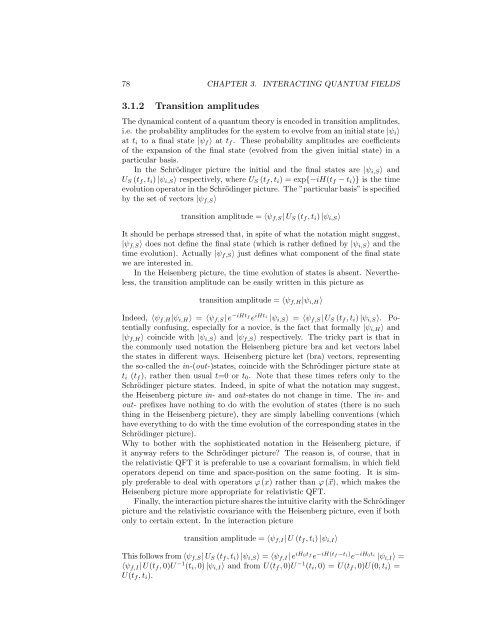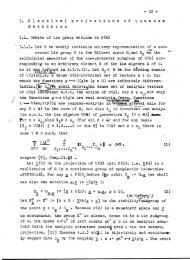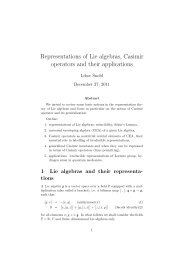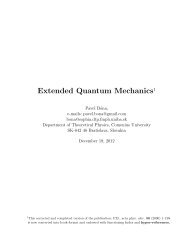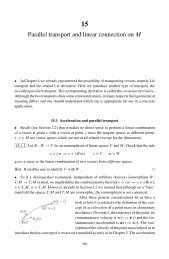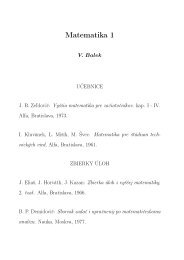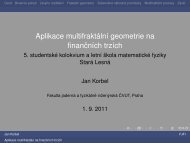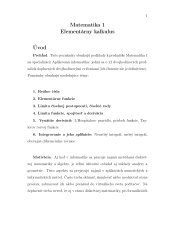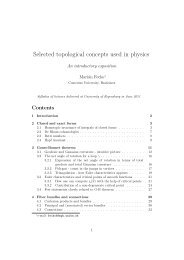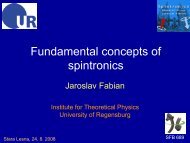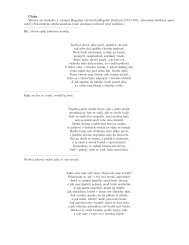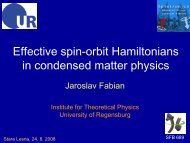Quantum Field Theory I
Quantum Field Theory I
Quantum Field Theory I
You also want an ePaper? Increase the reach of your titles
YUMPU automatically turns print PDFs into web optimized ePapers that Google loves.
78 CHAPTER 3. INTERACTING QUANTUM FIELDS<br />
3.1.2 Transition amplitudes<br />
The dynamicalcontentofaquantum theoryisencoded in transitionamplitudes,<br />
i.e. the probability amplitudes for the system to evolve from an initial state |ψ i 〉<br />
at t i to a final state |ψ f 〉 at t f . These probability amplitudes are coefficients<br />
of the expansion of the final state (evolved from the given initial state) in a<br />
particular basis.<br />
In the Schrödinger picture the initial and the final states are |ψ i,S 〉 and<br />
U S (t f ,t i )|ψ i,S 〉 respectively, where U S (t f ,t i ) = exp{−iH(t f −t i )} is the time<br />
evolutionoperatorin theSchrödingerpicture. The”particularbasis”isspecified<br />
by the set of vectors |ψ f,S 〉<br />
transition amplitude = 〈ψ f,S |U S (t f ,t i )|ψ i,S 〉<br />
It should be perhaps stressed that, in spite of what the notation might suggest,<br />
|ψ f,S 〉 does not define the final state (which is rather defined by |ψ i,S 〉 and the<br />
time evolution). Actually |ψ f,S 〉 just defines what component of the final state<br />
we are interested in.<br />
In the Heisenberg picture, the time evolution of states is absent. Nevertheless,<br />
the transition amplitude can be easily written in this picture as<br />
transition amplitude = 〈ψ f,H |ψ i,H 〉<br />
Indeed, 〈ψ f,H |ψ i,H 〉 = 〈ψ f,S |e −iHt f<br />
e iHti |ψ i,S 〉 = 〈ψ f,S |U S (t f ,t i )|ψ i,S 〉. Potentially<br />
confusing, especially for a novice, is the fact that formally |ψ i,H 〉 and<br />
|ψ f,H 〉 coincide with |ψ i,S 〉 and |ψ f,S 〉 respectively. The tricky part is that in<br />
the commonly used notation the Heisenberg picture bra and ket vectors label<br />
the states in different ways. Heisenberg picture ket (bra) vectors, representing<br />
the so-called the in-(out-)states, coincide with the Schrödinger picture state at<br />
t i (t f ), rather then usual t=0 or t 0 . Note that these times refers only to the<br />
Schrödinger picture states. Indeed, in spite of what the notation may suggest,<br />
the Heisenberg picture in- and out-states do not change in time. The in- and<br />
out- prefixes have nothing to do with the evolution of states (there is no such<br />
thing in the Heisenberg picture), they are simply labelling conventions (which<br />
have everything to do with the time evolution of the corresponding states in the<br />
Schrödinger picture).<br />
Why to bother with the sophisticated notation in the Heisenberg picture, if<br />
it anyway refers to the Schrödinger picture The reason is, of course, that in<br />
the relativistic QFT it is preferable to use a covariant formalism, in which field<br />
operators depend on time and space-position on the same footing. It is simply<br />
preferable to deal with operators ϕ(x) rather than ϕ(⃗x), which makes the<br />
Heisenberg picture more appropriate for relativistic QFT.<br />
Finally, theinteractionpicturesharestheintuitiveclaritywiththeSchrödinger<br />
picture and the relativistic covariance with the Heisenberg picture, even if both<br />
only to certain extent. In the interaction picture<br />
transition amplitude = 〈ψ f,I |U (t f ,t i )|ψ i,I 〉<br />
Thisfollowsfrom〈ψ f,S |U S (t f ,t i )|ψ i,S 〉 = 〈ψ f,I |e iH0t f<br />
e −iH(t f−t i) e −iH0ti |ψ i,I 〉 =<br />
〈ψ f,I |U(t f ,0)U −1 (t i ,0)|ψ i,I 〉 and from U(t f ,0)U −1 (t i ,0) = U(t f ,0)U(0,t i ) =<br />
U(t f ,t i ).


